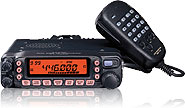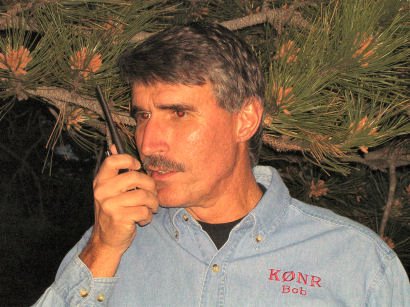Portable VHF/UHF Repeater Project
 My latest ham radio project is assembling a portable repeater for VHF and UHF operation. The basic idea is to package two VHF/UHF transceivers and a repeater controller into a rack mount box that can be easily transported and powered from a 12 VDC source.
My latest ham radio project is assembling a portable repeater for VHF and UHF operation. The basic idea is to package two VHF/UHF transceivers and a repeater controller into a rack mount box that can be easily transported and powered from a 12 VDC source.I chose the Yaesu FT-7800R for the transceivers since it covers the 2M and 70 cm bands and has a data/packet port for easy access to the required control signals. Specifically, the data port has transmit audio in, receive audio out, squelch signal and PTT (Push To Talk). The repeater controller used is the NHRC-6, which is designed for use as a bridging controller between two transceivers. Most repeater controllers are set up for a conventional repeater configuration, always receiving on one frequency and always transmitting on another. I plan to use the repeater in this mode (on the 70 cm band, with a small UHF duplexer) but also wanted to run the transceivers in a crossband repeat mode. The NHRC-6 handles this quite well, able to route audio in both directions between two transceivers and with identification support for both rigs.
I've got the system assembled and I am playing around with the configuration. More to follow, probably in a CQ VHF article.
73 Bob K0NR



3 Comments:
A couple of years ago I built a simplex UHF node for IRLP. Although I had been a ham for nearly 30 years, I had no experience with building a repeater or node. I am amazed at the technology and "smarts" required to build, install and maintain a good sounding, reliable repeater--something I had always taken for granted.
One of the issues that I had never previously considered was the incredible duty-cycle that is required of a heavily used system.
It will be interesting to hear how the 7800s hold up under load. Please keep us posted as it sounds like an interesting project!
73 de Jeff
Jeff,
The duty cycle issue on a repeater is very real. Most transceivers assume no more than 50% duty cycle....I transmit and then I receive. I plan to run the FT-7800R's on less than full power. They run 50W on 2 meters, which would be too much power if left keyed down for a long time. I am still experimenting with what power level is sustainable
Bob,
I installed two small muffin fans on the heat sink of my node radio - a 25 watt Motorola GM300. It stays reasonably cool but even with that I notice the rig getting pretty hot when listening to a long winded Net.
73 de Jeff
Post a Comment
Links to this post:
Create a Link
<< Home